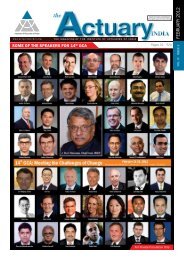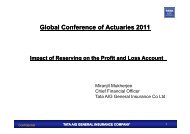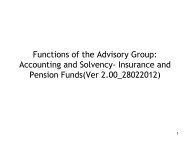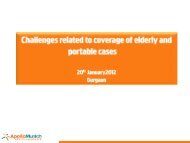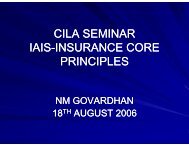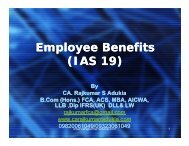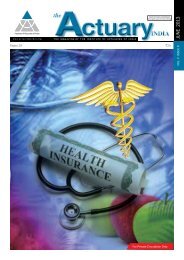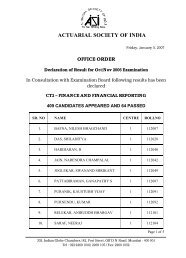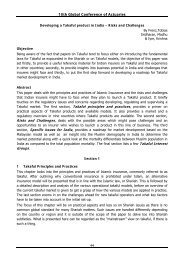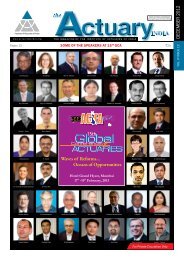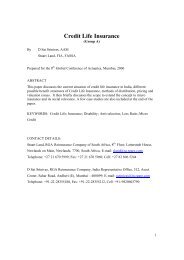Financial Reinsurance - Actuarial Society of India
Financial Reinsurance - Actuarial Society of India
Financial Reinsurance - Actuarial Society of India
- No tags were found...
You also want an ePaper? Increase the reach of your titles
YUMPU automatically turns print PDFs into web optimized ePapers that Google loves.
<strong>Financial</strong> <strong>Reinsurance</strong> :Experiences and LessonsChantal BlackieChief Business Development Officer -Hannover Life Re Bermuda LtdBermudaMeeting the Challenges <strong>of</strong> Change14 th Global Conference <strong>of</strong> Actuaries19 th – 21 st Feb, 2012 | Mumbai, <strong>India</strong>
Myth 1: <strong>Financial</strong> <strong>Reinsurance</strong> differsmaterially from Traditional <strong>Reinsurance</strong>• Traditional <strong>Reinsurance</strong>: The transfer <strong>of</strong> insurance risks from theceding company to the reinsurance company, to reduce the risk andvolatility in the ceding company’s results.• <strong>Financial</strong> <strong>Reinsurance</strong>: A type <strong>of</strong> reinsurance transacted for thepurpose <strong>of</strong> achieving a desired effect on the ceding company’sfinancial statements, e.g. to improve the balance sheet position.• T Both The transfer <strong>Financial</strong> <strong>of</strong> insurance and risk from the ceding company to the reinsurancecompany with the aim to The transfer <strong>of</strong> insurance risk from theTraditional <strong>Reinsurance</strong>achieve risk transfer andfinancial objectives• <strong>Financial</strong> <strong>Reinsurance</strong> isbest defined according tothe intent <strong>of</strong> the transactionTraditional<strong>Reinsurance</strong><strong>Financial</strong><strong>Reinsurance</strong>Risktransfereffect<strong>Financial</strong>effect
Myth 2: <strong>Financial</strong> reinsurance is“cooking the books”• Cash financing: The initial transaction involves a cash payment fromthe reinsurance company to the ceding company.Subsequent transactions involve the repayment <strong>of</strong>this financing, plus a fee, from the ceding companyto the reinsurance company• Comparable to “sale and lease back” arrangement• Cash financing adds an asset140120100Capital80Financing60Liabs40Assets200AssetsBeforeLiabsBeforeAssetsAfterLiabs After
Myth 2: <strong>Financial</strong> reinsurance is“cooking the books”• Non-cash financing: The initial transaction involves no net cash flowbetween the reinsurer and the ceding company.Subsequent transactions involve the payment <strong>of</strong>a fee from the ceding company to the reinsurer• Comparable to a “stop loss” arrangement• Non-cash financing removes a liability120100806040CapitalFinancingLiabsAssets200AssetsBeforeLiabsBeforeAssetsAfterLiabs After
Myth 3: <strong>Financial</strong> reinsurance contains norisk to the reinsurerRisks faced by reinsurer• Actual experience (mortality/morbidity/lapses) worse thananticipated best estimate takes much longer to repay and mightnot repay at all losses in excess <strong>of</strong> initial financing amount• Insolvency <strong>of</strong> ceding company ranks below policyholdersbenefits and alongside all other unsecured creditors <strong>of</strong> company• Remote risks taken on materialize pay losses far exceeding anyfee earned prior to that
Myth 4: <strong>Financial</strong> reinsurance providesno benefits to policyholders<strong>Financial</strong> reinsurance optimize the ceding company’s capital position:• Greater capital freedom leads to enhance products e.g. enhancedguarantees & additional product features• Supports high initial distribution cost leading to even distribution <strong>of</strong>charges• Lower cost <strong>of</strong> capital leading to more competitive prices• Improved solvency ratio leads to better policyholder protection
Equity Funding US:Myth 5: <strong>Financial</strong> reinsurance causes thefailure <strong>of</strong> insurance companies• Ceding company falsified policies which were then reinsured on acash basis with the reinsurer• Problem = IT fraud by insurerChiyoda Mutual Life Japan• Reinsured pr<strong>of</strong>itable blocks <strong>of</strong> business to hide investment lossesarising on other blocks• Problem = How long should directors try to “save” company beforethey are deemed to be committing fraud?Equitable Life UK• Entered into a reinsurance contract which allowed them to getreserve relief• Problem = Side letter was put in place between ceding companyand reinsurer to negate effect <strong>of</strong> the contract
Myth 6: <strong>Financial</strong> reinsurance can savefailing companies• No expected future pr<strong>of</strong>it = No financing opportunity• Ceding companies need to pay attention to:- flawed product design which will increase lapses- underpriced/cross subsidized business- expense overrun• <strong>Financial</strong> reinsurance can’t change the underlying economics <strong>of</strong> thebusiness
Myth 7: <strong>Financial</strong> reinsurance does notrequire additional regulatory considerationsImportant considerations for Regulators:• Definition <strong>of</strong> reinsurance• Approved forms <strong>of</strong> reinsurance• Approved reinsurance companies• Rules for non-approved companies• Contract wording requirements• Capital and solvency requirements• Collateral requirements for foreign reinsurers• Tax rules• Accounting rules• Extent and frequency <strong>of</strong> oversight
Myth 8: All regulatory regimes shouldbe equal• Import and export play important roles in our economies• <strong>Reinsurance</strong> is “just another” form <strong>of</strong> International trade• Regulatory arbitrage doesn’t equal improper conduct• Regulators should choose to implement a regime which:a) Allows the Regulator to remain “in control”b) Allows Industry to benefit from additional solutionsc) Allows the most suitable companies to provide solutions in apr<strong>of</strong>essional way
Myth 9: <strong>Financial</strong> reinsurance dilutesthe shareholders investmentWhy does a shareholder buy shares in a company?• Receive the future pr<strong>of</strong>its through a dividend• Expect an increase in the share price which leads to capitalappreciation• Right to “control”/influence company direction through voting rightsWhat impact does financial reinsurance have on these items?• Capitalize future pr<strong>of</strong>its and make it available to company in cash• Protects shareholders downside risk that actual future pr<strong>of</strong>its are lessthan anticipated• Makes available additional capital from within the company without theneed to sell more shares and therefore diluting current investments• Could be utilized as a temporary source <strong>of</strong> capital• Could be a cheaper source <strong>of</strong> capital• Lead to expansion <strong>of</strong> business and potentially more pr<strong>of</strong>its for existingshareholders



